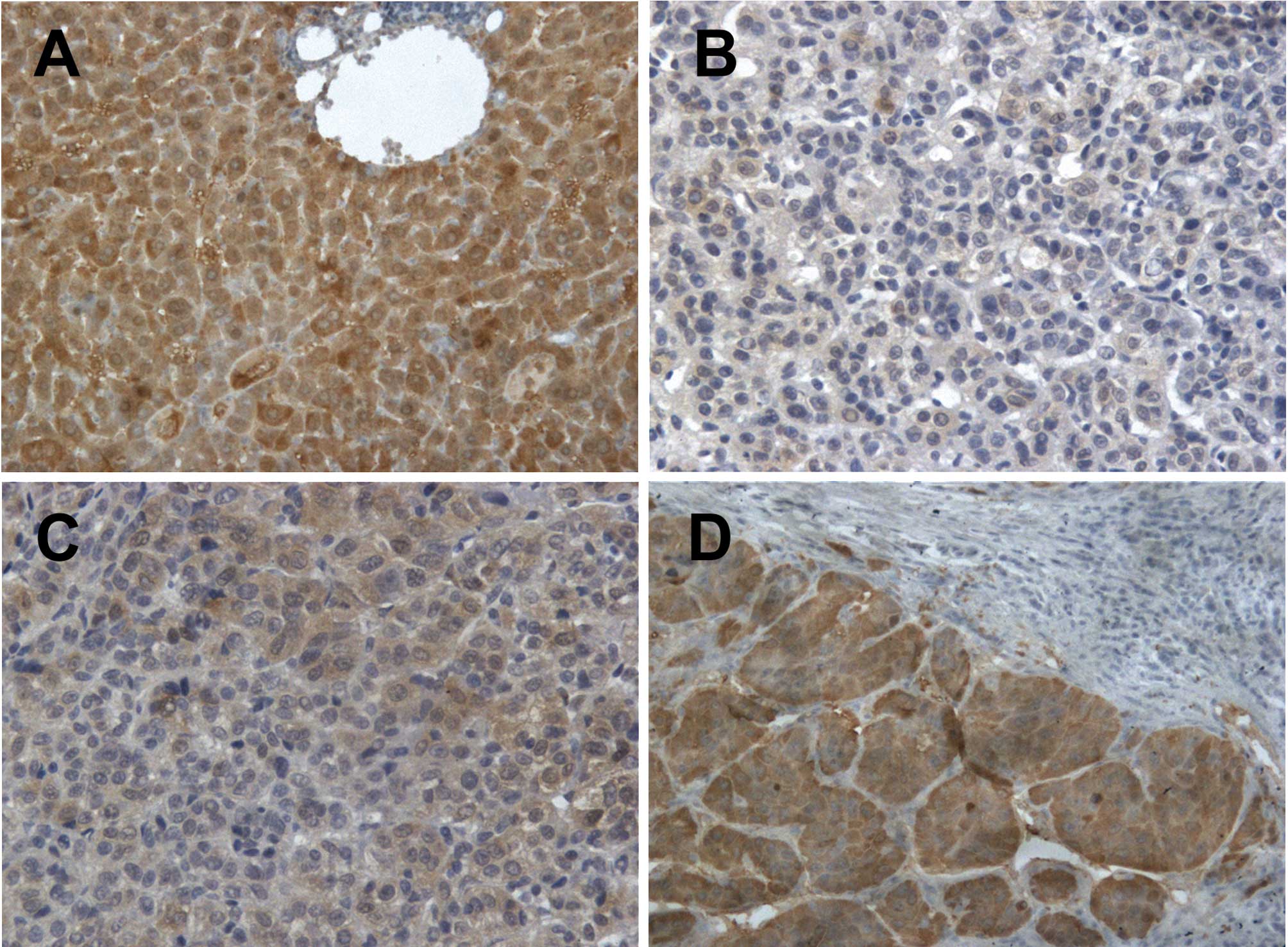|
1
|
Bosch FX, Ribes J, Cleries R and Diaz M:
Epidemiology of hepatocellular carcinoma. Clin Liver Dis.
9:191–211. 2005. View Article : Google Scholar : PubMed/NCBI
|
|
2
|
Farazi PA and DePinho RA: The genetic and
environmental basis of hepatocellular carcinoma. Discov Med.
6:182–186. 2006.PubMed/NCBI
|
|
3
|
Farazi PA and DePinho RA: Hepatocellular
carcinoma pathogenesis: from genes to environment. Nat Rev.
6:674–687. 2006. View
Article : Google Scholar : PubMed/NCBI
|
|
4
|
Suriawinata A and Xu R: An update on the
molecular genetics of hepatocellular carcinoma. Semin Liver Dis.
24:77–88. 2004. View Article : Google Scholar : PubMed/NCBI
|
|
5
|
Tanaka S, Mogushi K, Yasen M, Noguchi N,
Kudo A, Kurokawa T, Nakamura N, Inazawa J, Tanaka H and Arii S:
Surgical contribution to recurrence-free survival in patients with
macrovascular-invasion-negative hepatocellular carcinoma. J Am Coll
Surg. 208:368–374. 2009. View Article : Google Scholar : PubMed/NCBI
|
|
6
|
Kamiyama T, Nakanishi K, Yokoo H, Kamachi
H, Tahara M, Suzuki T, Shimamura T, Furukawa H, Matsushita M and
Todo S: Recurrence patterns after hepatectomy of hepatocellular
carcinoma: implication of Milan criteria utilization. Ann Surg
Oncol. 16:1560–1571. 2009. View Article : Google Scholar : PubMed/NCBI
|
|
7
|
Kaibori M, Ishizaki M, Saito T, Matsui K,
Kwon AH and Kamiyama Y: Risk factors and outcome of early
recurrence after resection of small hepatocellular carcinomas. Am J
Surg. 198:39–45. 2009. View Article : Google Scholar : PubMed/NCBI
|
|
8
|
Grabon W: Arginine as a crucial amino acid
in carcinogenesis and tumor growth. Postepy Hig Med Dosw.
60:483–489. 2006.PubMed/NCBI
|
|
9
|
Wu G and Morris SM Jr: Arginine
metabolism: nitric oxide and beyond. J Biochem. 336:1–17. 1998.
|
|
10
|
Husson A, Brasse-Lagnel C, Fairand A,
Renouf S and Lavoinne A: Argininosuccinate synthetase from the urea
cycle to the citrulline-NO cycle. Eur J Biochem. 270:1887–1899.
2003. View Article : Google Scholar : PubMed/NCBI
|
|
11
|
Cheng PN, Lam TL, Lam WM, Tsui SM, Cheng
AW, Lo WH and Leung YC: Pegylated recombinant human arginase
(rhArg-peg5,000 mw) inhibits the in vitro and in vivo proliferation
of human hepatocellular carcinoma through arginine depletion.
Cancer Res. 67:309–317. 2007. View Article : Google Scholar
|
|
12
|
Wheatley DN and Campbell E: Arginine
catabolism, liver extracts and cancer. Pathol Oncol Res. 8:18–25.
2002. View Article : Google Scholar : PubMed/NCBI
|
|
13
|
Feun L, You M, Wu CJ, Kuo MT, Wangpaichitr
M, Spector S and Savaraj N: Arginine deprivation as a targeted
therapy for cancer. Curr Pharm Des. 14:1049–1057. 2008. View Article : Google Scholar : PubMed/NCBI
|
|
14
|
Dillon BJ, Prieto VG, Curley SA, Ensor CM,
Holtsberg FW, Bomalaski JS and Clark MA: Incidence and distribution
of argininosuccinate synthetase deficiency in human cancers: a
method for identifying cancers sensitive to arginine deprivation.
Cancer. 100:826–833. 2004. View Article : Google Scholar
|
|
15
|
Ensor CM, Holtsberg FW, Bomalaski JS and
Clark MA: Pegylated arginine deiminase (ADI-SS PEG20,000 mw)
inhibits human melanomas and hepatocellular carcinomas in vitro and
in vivo. Cancer Res. 62:5443–5450. 2002.PubMed/NCBI
|
|
16
|
Yoon CY, Shim YJ, Kim EH, Lee JH, Won NH,
Kim JH, Park IS, Yoon DK and Min BH: Renal cell carcinoma does not
express argininosuccinate synthetase and is highly sensitive to
arginine deprivation via arginine deiminase. Int J Cancer.
120:897–905. 2007. View Article : Google Scholar : PubMed/NCBI
|
|
17
|
Bowles TL, Kim R, Galante J, Parsons CM,
Virudachalam S, Kung HJ and Bold RJ: Pancreatic cancer cell lines
deficient in argininosuccinate synthetase are sensitive to arginine
deprivation by arginine deiminase. Int J Cancer. 123:1950–1955.
2008. View Article : Google Scholar : PubMed/NCBI
|
|
18
|
Park H, Lee JB, Shim YJ, Shin YJ, Jeong
SY, Oh J, Park GH, Lee KH and Min BH: Arginine deiminase enhances
MCF-7 cell radiosensitivity by inducing changes in the expression
of cell cycle-related proteins. Mol Cell. 25:305–311.
2008.PubMed/NCBI
|
|
19
|
Kim JH, Kim JH, Yu YS, Kim DH, Min BH and
Kim KW: Anti-tumor activity of arginine deiminase via arginine
deprivation in retinoblastoma. Oncol Rep. 18:1373–1377.
2007.PubMed/NCBI
|
|
20
|
Scott L, Lamb J, Smith S and Wheatley DN:
Single amino acid (arginine) deprivation: rapid and selective death
of cultured transformed and malignant cells. Br J Cancer.
83:800–810. 2000. View Article : Google Scholar : PubMed/NCBI
|
|
21
|
Ascierto PA, Scala S, Castello G, Daponte
A, Simeone E, Ottaiano A, Beneduce G, De Rosa V, Izzo F, Melucci
MT, Ensor CM, Prestayko AW, Holtsberg FW, Bomalaski JS, Clark MA,
Savaraj N, Feun LG and Logan TF: Pegylated arginine deiminase
treatment of patients with metastatic melanoma: results from phase
I and II studies. J Clin Oncol. 23:7660–7668. 2005. View Article : Google Scholar : PubMed/NCBI
|
|
22
|
Izzo F, Marra P, Beneduce G, Castello G,
Vallone P, De Rosa V, Cremona F, Ensor CM, Holtsberg FW, Bomalaski
JS, Clark MA, Ng C and Curley SA: Pegylated arginine deiminase
treatment of patients with unresectable hepatocellular carcinoma:
results from phase I/II studies. J Clin Oncol. 22:1815–1822. 2004.
View Article : Google Scholar : PubMed/NCBI
|
|
23
|
Takaku H, Matsumoto M, Misawa S and
Miyazaki K: Anti-tumor activity of arginine deiminase from
Mycoplasma argini and its growth-inhibitory mechanism. Jpn J Cancer
Res. 86:840–846. 1995. View Article : Google Scholar : PubMed/NCBI
|
|
24
|
Hurwitz R and Kretchmer N: Development of
arginine-synthesizing enzymes in mouse intestine. Am J Physiol.
251:103–110. 1986.PubMed/NCBI
|











